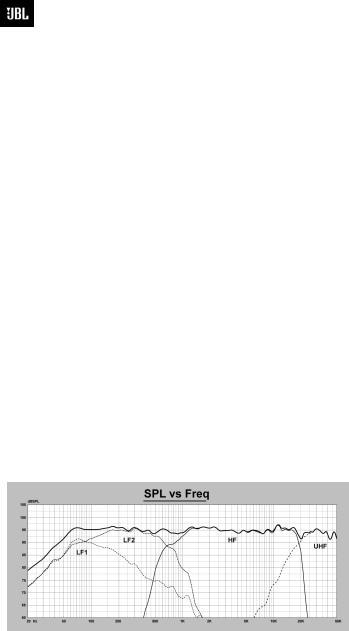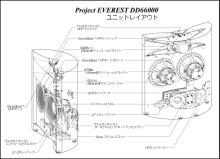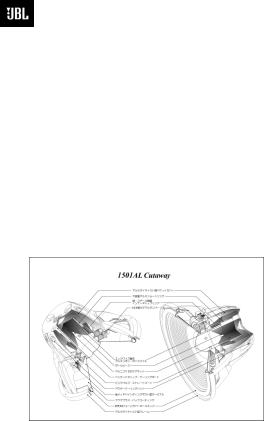JBL DD66000 User Manual

Project EVEREST DD66000
Project EVEREST DD66000
Product Commentaries
and User Guide
Thank you for purchasing Project EVEREST DD66000 loudspeaker system.
Before using the system, please take time to read through this user guide to understand well on this product and also to use it properly.

User's Guide Table of Contents
Chapter 1
Preface
Chapter 2
Legacy
Chapter 3
Project EVEREST DD66000
Chapter 4
Unpacking
Chapter 5
Selecting Cable
Chapter 6
Amplifier Recommendations
Chapter 7
Placement and Set-up Considerations
Chapter 8
Switch Operations
Chapter 9
Connections
Chapter 10
Care and Maintenance
Chapter 11
Troubleshooting and Service Guide
Chapter 12
Ownership Register
Chapter 13
Project EVEREST DD66000 Specifications
Project EVEREST DD66000
CHAPTER 1
Preface
JBL wishes to thank you for selecting a Project EVEREST DD66000 loudspeaker system. It represents the sum total of our research and developmental efforts in sound reproduction over the last half century. We have labored to create a loudspeaker system with no acoustical or electrical limitations whatsoever. While the Project Everest DD66000 loudspeaker is itself a new development, the goal behind it goes right back to the earliest days of the original James B. Lansing Sound Company.
But it is your listening pleasure that ultimately determines how successful we are in this endeavor. It is solely in the interest of ensuring a perfect listening experience that we ask you to faithfully follow the set-up and operation procedures outlined in the Project EVEREST DD66000 Owner’s Reference.
This manual exists for several purposes.
As your owner's manual, it contains all necessary background information and detailed instructions for setting up your Project EVEREST DD66000 loudspeaker system, including unpacking the loudspeaker, selecting the correct location, speaker wire, wiring scheme and amplification, and connecting it up to its associated electronics. This information will be found in Chapters 4 through 8. In addition, we have included a detailed description of your Project EVEREST DD66000 loudspeakers (Chapter 3) so that you may become thoroughly acquainted with its unique design and technological features.
Although physically and materially imposing, the set-up procedure of the Project EVEREST DD66000 loudspeaker system is relatively simple. We strongly urge you to read this manual thoroughly before you begin, and consult it frequently throughout the process. Considerations must be made in placing the speakers; their stature makes it imperative that you become familiar with the entire set-up process in advance.
Also, we believe that the historical and technical information included will add immeasurably to your total enjoyment of the loudspeaker system. As a loudspeaker, Project EVEREST DD66000 is unparalleled in the field of sound reproduction. The story and principles behind it are an interesting, informative and fitting precursor to a lifetime of musical enjoyment.

CHAPTER 2
Legacy - the historical development of the JBL Project loudspeakers
Of those few who seek perfection in sound reproduction, only a handful have actually achieved it. The price is always high. It is a rare occurrence indeed when an individual or group is able to triumph over the constraints of economic and technological reality just once.
At JBL, this has happened eight times. In each case, its engineers were told to build the speaker system they had always wanted to build. Whatever resources were required would be made available. Thus began an ongoing investigation into new frontiers of sound reproduction, beginning mid -century in 1950 and continuing to the present day.
The products that have resulted fromthis venture are now known as the JBL Project loudspeakers. Each represents the absolute peak of every technological, material and engineering innovation available at that time, combined into a single system. They are Hartsfield, Pragon, Everest DD55000, K2 S9500/7500, K2 S5500, K2 S9800 , and K2 S5800. The newest is EVEREST DD66000.
Although differing in performance details and physical attributes, each of the Project loudspeakers has shared a common objective: to elevate sound reproduction to levels defined only by the limitations of existing materials and technology. And despite a spread of nearly sixty years, all Project loudspeakers have shared many common features testimony to their foundation on the technology and manufacturing techniques upon which JBL was built.
Defining the Project Concept
The Hartsfield began a tradition at JBL that continues today. First, engineer a product as close to perfection as possible. When it reaches that level, that is the time to make it better.
In 1954, the Hartsfield was significant not in that it represented new technology, but rather a new level of the all technical manufacturing approach pioneered by James B. Lansing some twenty years before it. Like its Project series successors, it was a high efficiency system incorporating compression driver technology, one combining the qualities of high output, low distortion, exceptional stereo imaging and fatigue-free listening. Most important, it was
the first consumer-available listening system to do so.
Project EVEREST DD66000
In this respect, Project EVEREST DD66000 is at once the most advanced and sophisticated loudspeaker in the world today and a speaker whose technology is deeply rooted in over 60 years of tradition. JBL's president in 1954, Willia m Thomas, described the Hartsfield as "...the speaker system we have always wanted to build ... the finest components ever made available to serious listeners . "
He went on to describe the process behind his creation: “Most people who own and appreciate fine sound reproduction equipment look forward to the day when they will be able to assemble a system without limitation in just exactly the way they think it should be done. Periodically a manufacturer gets this same feeling ... The science of acoustics has provided us with basic
principles-available to all for achieving precision reproduction. It is only a matter of incorporating these methods into a system design, and then taking every bit of trouble necessary to build a system precisely to the design.”
"It isn't easy, but that's the way it is done . "
The Ranger-Paragon, JBL's second Project system, was the first serious attempt at a reflecting speaker system, and broke ground in the new concept of stereo imaging. Essentially two independent full-range speaker systems installed in a handsome curved cabinet nearly 9 feet (2.7 metre) long, the Paragon's enclosure was treated as an extension of its transducers. In essence, the system had its own "built-in acoustics." In many respects the Paragon anticipated loudspeaker developments that would occur years-and even decades -later. This “built-in acoustics” concept is inherited in the latest Project EVEREST DD66000.
For nearly 30 years, the Paragon remained the most acoustically viable sound system for the home. Today, along with the Hartsfield, it is still the most sought-after speaker in the world.
In 1986, JBL introduced a new Project system that retained the Paragon's overall sense of musicality while upgrading its character by incorporating three decades' worth of continuous development in every facet of its design. Its name reflected the pinnacle of achievement it represented: Project Everest. This was the original Project EVEREST DD55000.
For the first time, the rest of the sound reproduction chain - and not the loudspeaker or its transducers - would impose limits on overall system performance. Like the Paragon and Hartsfield, Project Everest was built around compression driver technology and addressed a more refined stereo image than was previously considered technically feasible.

Since Project Everest was introduced, sound recording and playback technology has undergone a revolution of its own. With the advent of CD, extremely demanding recorded signals had become the rule rather than the exception - the average source material used by the typical audio enthusiast had become superior to the best demonstration material of even just a few years ago. In overall dynamics and transient response, transducers are once again a potential weak link in the high-end audio reproduction chain.
It was in this environment that JBL set out to create its fourth and fifth Project loudspeakers, K2 S9500 and K2 S5500. As with Hartsfield, the puritan simplicity of a two-way system was considered the most promising design track. Advances in transducer design and low frequency alignment would make the construction of a two-way system of unprecedented physical and acoustical scale possible. Engineers took the core components - the low and high frequency drivers - and optimized them by redesigning their magnetic structures, diaphragms and framework for greater linearity, dynamic capability and transient response.
In the years following the introduction of the K2 S9500 and K2 S5500, sound reproduction technology underwent another series of revolutionary changes, with the introduction of DVD-Video, Dolby Digital, DTS, DVD-Audio, and Super Audio CD (SACD). Frequency responses to 50 kHz and 3-digit dynamic range and signal-to-noise ratios have now become commonplace. In order to faithfully reproduce such robust sonic properties, the loudspeaker needed to undergo drastic improvements to its transducer, network and enclosure technologies .
The new K2 S9800 employed a 3-way design, incorporating an Ultra High Frequency (UHF) compression driver and horn to reproduce high frequencies up to 50 kHz. With the UHF handling the high frequencies, the High Frequency (HF) transducer could then be upgraded to a new design using a 3 inch diaphragm for better reproduction of lower frequencies and better blend with the woofer than the older generations’ 2-inch diaphragm. Both compression drivers utilized newly developed Beryllium diaphragms to provide the lowest distortion and flattest frequency response possible.
In order to recreate the extremely high dynamic range provided by today’s audio sources, a brand new low frequency transducer was developed from ground up, utilizing an Alnico magnet, 4-inch edge wound Voice Coil, and a 15 inch cone. Extensive computer-aided engineering and design effort made to develop the optimized port tuning employed in Project K2 S9800 has resulted in a significant advance in the concept of state-of-the-art acoustic reproduction.
Project EVEREST DD66000
As an outcome of the K2 development, a loudspeaker system with higher sensitivity and wider dynamic range became reality without power compression or distortion even at an extremely high drive level.
The development of the Project EVEREST DD66000 loudspeaker system was started as a celebration of JBL’s 60th Anniversary and as a realization of the above-mentioned potentials . The solemn personality of the Hartsfield, exceptional wood-craftsmanship of the Paragon, “built-in acoustics” which considers the enclosure as an extension of transducers , and the state-of-the-art transducer technologies that were build up from two generations of the Project K2 developments are poured into this new challenge to the acoustical and electrical limitations in the second model of the Project Everest.
Despite its power and sophistication, Project EVEREST DD66000 is a marriage of tradition and technology. It reflects the design, material, engineering and manufacturing expertise derived and refined through nearly six decades of experience that are the exclusive province of one loudspeaker builder: JBL.

CHAPTER 3
The Project EVEREST DD66000 loudspeaker: a triumph in acoustics and technology
The following sections describe the primary features and components of the
Project EVEREST DD66000 loudspeaker system.
The basic system configuration is what JBL has historically referred to as an augmented 2-way. In the 1950’s and 1960’s JBL built primarily 2-way systems with a 12” or 15” woofer crossed over to a large format compression driver/horn combination. Some of the systems would be “augmented” by a
UHF device, most usually the 075 ring radiator that would operate above 8 kHz. These systems would have only a single crossover point in the middle of the audio range in an attempt to minimize any sonic degradation caused by the dividing network. The DD66000 has a single midrange crossover at 700 Hz blending one 1501Al woofer to the 476Be compression driver and horn combination. The 045Be -1 UHF driver is brought in at 20 kHz to cover an
octave and a half of ultrasonic frequencies. A second 1501Al operates in the bass frequency range from below 30 Hz to around 150 Hz where it is rolled off at a gradual 6 dB/Octave. The first order slope ensures proper amplitude and phase summing between the two woofers over their total operating range. Both woofers operate below 150 Hz but only one of them extends up to the 700 Hz crossover point. This is done to achieve proper directivity control throughout the entire woofer operating range while delivering powerful and extended low frequency performance. Above 700 Hz, the HF compression driver and horn combination operates unassisted all the way to 20 kHz. (Fig.1)
Figure 1 – On-Axis response of the DD66000 system and that of each of the transducers through its crossover network. (2.83V @ 1m)

Project EVEREST DD66000
The transducers, horns and crossover networks are housed in a visually stunning enclosure that is reminiscent of both the Hartsfield and Paragon systems. The specially curved baffle provides the sidewalls for the main horn. The top and bottom horn flares are accomplished by the attachment of precision molded SonoGlass™ horn “lips” to the upper enclosure surface. The UHF driver is mounted to a SonoGlass™ horn which is itself mounted to the back of the die cast aluminum housing.
All of the enclosure is 25 mm MDF. The complex bracing is used to precisely hold the curved panels in exactly the correct shape allowing exceptional fit and consistency.
The woofer baffle module is a 6-sided shell and form an extremely rigid and secure final structure. A leather covered outer baffle is then applied giving the total combined woofer baffle a thickness of 45 mm. The outer baffle is removable should repair or replacement of the leather surface ever be necessary.
The system is ported on the rear with a tuning frequency of 34 Hz. Two large 100 mm diameter flared ports are combined with the input connections on a massive 3-piece die cast aluminum structure. The entire enclosure rests on 4 stainless steel foot assemblies. Stainless steel coasters are included to protect wood and tile floors from damage from the spike feet. The grille assembly is constructed of MDF and uses a thick, perforated metal sheet to provide the curved shape. The grille is held on the enclosure using metal pins and rubber cups.
The 1501Al and 476Be are both designed to be absolute minimum distortion drive units. Although they are capable of tremendous acoustic output, their design intent is to be completely linear in every way up to a reasonable drive level. This enables the system to sound the same regardless of playback level.

TRANSDUCERS
The 1501AL Low Frequency Driver
See Figure 2
The 1501A L Low Frequency driver is very similar to the 1500A L used in the S9800 system. It incorporates a new high impedance voice coil to allow a pair of woofers to be used while still maintaining an 8 ohm system impedance. The voice coil length has been increased to 30.5 mm (from 20.3 mm) and its milling width has been reduced slightly. This was done to allow greater clearance from the outer diameter of the coil to the laminated top plate and to provide a larger surface area of coil surface for heat dissipation. These coil improvements allow the 1501A L to handle up to 25% more power than the 1500A L.
Figure 2 – 1501AL section view
The 1500AL LF driver is a 380 mm diameter device with a 100 mm voice coil completely immersed in a radial field generated by an Alnico 5DG magnet. Alnico was chosen because of its stable operating point. This material is insensitive to temperature changes and back EMF from the coil. JBL has overcome the tendency of Alnico to demagnetize with high drive by utilizing a massive shorting ring at the base of the motor assembly. The top plate is constructed of alternating copper-steel laminations. The presence of the copper rings linearizes the magnetic properties of the gap to all but eliminate eddy current distortion.
The outer suspension is made of EPDM foamed rubber, which has the longevity and frequency response characteristics of traditional rubber surrounds, but with a low density very close to that of foam surrounds. Low loss EPDM material was chosen so that the transient detail of musical signals could be preserved. Dual inverted Nomex spiders are employed for the cancellation of
